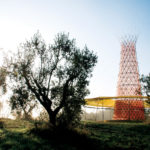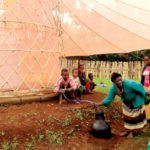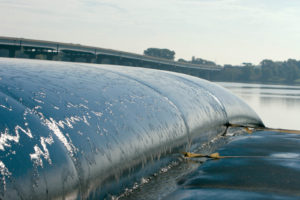
If you’ve had a glass of clean water today, you can likely thank a fabric-based product. Engineered fabrics, membranes and geosynthetics perform behind-the-scenes work to ensure that communities have access to adequate potable water and clean waterways. Creative fabric uses also hold promise in delivering clean water in emerging markets—a meteoric task considering that 783 million people don’t have access to this limited resource. From wastewater treatment to environmental remediation, fabrics offer flexible, cost-effective solutions worldwide more efficiently and economically (and more quickly) than many other materials.
A strong performance
Companies that are in the business of protecting and preserving the world’s limited water resources must meet numerous technical, performance and regulatory requirements. Cooley Group, Pawtucket, R.I., manufactures and distributes a variety of geomembranes used in the global potable-water market. These include reservoir covers and liners for primary and secondary water and wastewater containment, as well as cured-in-place piping membranes employed to reline leaking, aged or otherwise damaged water and sewage pipes.
In the United Arab Emirates, Cooley supplied its oil boom containment material for prophylactic protection of the sea water intake into a Dubai Electricity and Water Authority desalination facility. Along with keeping debris and other foreign matter out of the desalination operation, the Cooley geomembrane protects the facility against a potential oil spill in the Persian Gulf.
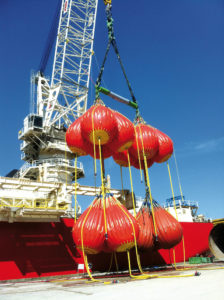
Cooley specifically engineers membranes according to the performance needs of the application, a process that begins with selecting the best supporting textile. “As the physical property requirements of the membrane increase, so does the sophistication of the fabric construction, including higher tenacity yarns, higher sleys, rip stops, double picks and so on,” says Dan Dwight, Cooley Group president and CEO.
For water-conservation geomembrane applications, Cooley typically incorporates yarns with anti-wicking properties into its products. Dwight notes that the fabric in geomembranes “can be homogenous in their designs or highly engineered with specialty yarns strategically positioned within the fabric, to provide unique properties only where they are needed for the potable-water application.”
Cooley covers its fabrics with thermoplastic coating options ranging from PVC to TPU (thermoplastic polyurethane), resulting in geomembranes that preserve and protect water against evaporation and leakage, as well as against contamination from foreign sources and substances. The geomembranes can also store wastewater, regardless of contamination level.
Another advantage speaks to customers’ wallets. Not only do geomembranes cost less than permanent infrastructure, “they can be manufactured and installed to any specific application,” Dwight says. “They are easy to install and repair, if necessary, on-site.”
In 2017, Cooley released the Oasis® Floating Cover, a durable, high-performance ethylene interpolymer alloy (EIA) geomembrane designed for use on water reservoirs and certified for potable-water usage worldwide. The product—which utilizes DuPont™ Elvaloy® ethylene copolymer resins and Cooley’s proprietary TPA (triphenylamine) polymer, C3®—is antimicrobial and has high resistance to oxidation, ozone, ultraviolet (UV) light and weathering effects.
“Because the membrane does not cure, it allows for easy welding of strong reliable seams during the entire lifetime of the cover, with a 30-year warranty,” Dwight says.
Certifiably safe
At its facility in Bramsche, Germany, BondCote™, a Heytex Group company, manufactures coated fabrics for applications including pillow tanks, bladders and pit/basin/container liners. Polyester yarns woven in various ways serve as the basic carrier fabric, covered with calender coatings such as PVC for temporary storage and TPU or TPE (thermoplastic elastomer) for long-term storage. Calendering, a processing technology in which the rubber is pressed into textiles to form composite sheets, makes Heytex’s products 100 percent waterproof and airtight, and gives them an operating temperature range of –50°C to +90°C.
The coated fabrics have a number of other properties making them suitable for water infrastructure applications. They are free of heavy metals and plasticizers, and other potentially harmful substances do not migrate above the strictest legal limits. “Our products have high durability due to exceptionally good welding adhesion and low abrasion, strong UV- and weather-resistance, and high tensile strength and tear resistance specifically tailored to the application,” says Boris Kühling, product manager at Heytex.
Beyond those performance characteristics, coated fabrics also have to obtain the appropriate governmental or regulatory certifications, Kühling notes. Materials that come in contact with potable water must comply with regulations established by each region or country’s regulatory or certification agencies, such as the Food and Drug Administration (FDA) and National Science Foundation in the United States.
Do no harm
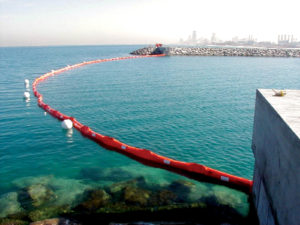
Gale Pacific, based in Braeside, Victoria, Australia, has prioritized environmental safety in the products it manufactures. The company specializes in the use of polyolefins—primarily polypropylene and polyethylene, both of which are 100 percent recyclable. “We almost never work with PVC, and this is by design,” says Ted Varani, vice president of commercial sales.
Aquamark® 400, a water- and effluent-containment textile manufactured by Gale Pacific, is used as a liner for earthen dams and ponds and for concrete or steel tanks, as well as for liquid transport vessels. Aquamark is made from a UV-stabilized polypropylene scrim with a UV-stabilized propylene coating, a construction that differs from most other effluent containment textiles.
“As a general rule, textile effluent management products contain plasticizers, which help make the coatings softer and more flexible,” says Varani. The downside to these additives, which usually include phthalates, heavy metals or chlorine, is that they can leach out into the water over time and create contamination. Because Gale’s technical textiles are made from either polyethylene or polypropylene, they don’t experience the same leaching issues.
“For the types of applications we target, being environmentally friendly is essential,” Varani says.
One of Gale Pacific’s primary customers in Australia uses polyethylene effluent containment textiles to fabricate a range of lay-flat hoses akin to a firehose, designed for water transfer and irrigation. The hoses were developed as an alternative to letting water run in open channels, which are subject to erosion, and the water itself subject to rapid evaporation.
The polyethylene hose system “satisfies a market demand for a product that is lightweight, more durable and able to carry higher volumes of water at higher pressures than unsupported fluming,” Varani says. The customer has been awarded large irrigation projects worldwide, including in Africa.
Contain and remediate
With its patented Geotube® technology, TenCate Geosynthetics of Pendergrass, Ga., aims to take away the bad and replenish the good. Geotube units provide
permeable containment of fills and wastes using specially engineered textiles. “These specially engineered textiles enable the passage of water while at the same time retain the solids component of the container fill and also any contaminants present,” says Chris Timpson, engineering business manager at TenCate Geosynthetics.
Geotube and geosystems technology—available in a number of sizes and shapes, including tubular, bag and mattress—focuses on two application areas: hydraulic engineering and environmental remediation. For hydraulic engineering applications, Geotube units contain sand fill in order to provide erosion-resistant structural units.
Acting as an alternative to the traditional solution of rocks and sand, the Geotube unit forms the core of a sand dune. A storm surge would remove only the sand covering the top of the Geotube container, which protects infrastructure located behind it from water flow. “With sea-level rise, Geotube hydraulic technology also can be used to protect inland and coastal waterways,” Timpson says.

On the environmental remediation side, Geotube technology is used in the removal of contaminated sediment often found in waterways into which industrial facilities have discharged their process water. The sediment can be removed using a mechanical system like a centrifuge, but the process takes a lot of equipment, labor and electricity, Timpson says.
Alternatively, “we pump the contaminated material into the Geotube units and contain all of those solids and then get rid of all the water waste,” he explains. This process, known as dewatering, “significantly reduces the sediment storage volume and renders the sediments into a solid, stable form that
can be easily transported to a landfill.”
Or—it could be reused. TenCate’s Geotube dewatering technology pulled double-duty for a shipping port terminal being developed in Brazil. The project’s owners needed to import 1.8 million cubic meters of fill to achieve the necessary platform elevation. And dredging an entry channel for container ships required the removal of 650,000 cubic meters of contaminated sediment.
Project engineers specified 169 Geotube units, into which the contaminated material was dredged, dewatered and consolidated. With the solids that remained, the Geotube bags served as the platform fill. Not only did the Geotube solution save developers the expense of acquiring additional land or taking up space within the site to store the contaminated sediment, it also eliminated 400,000 cubic meters of costly imported fill.
Progress through partnership
Fabric manufacturers and end product fabricators alike emphasize the importance of strong relationships throughout the entire supply chain. “Providing solutions to the market involves more than just our manufacturing methods; it also requires robust fabrication methods from our customers,” says Alan Marshall, senior product development engineer at Trelleborg Engineered Coated Fabrics, Rutherfordton, N.C.
Trelleborg partners with several fabricators that can mold or fabricate parts and a variety of geometries, as well as with adhesive manufacturers to provide assistance to customers in achieving finished product designs. “We also occasionally supply technical and tech service engineers to visit customers and support them during prototype development,” Marshall says.
The foundation of any healthy relationship is good communication.
“I make it a point to go to visit customers on their home turf and see with my own eyes the challenges and opportunities they face,” says Gale Pacific’s Varani. “Talking to customers only at industry events or via the phone isn’t enough.”
When supplying products to fabricators, Trelleborg’s primary requirement is to have as much information as possible regarding the product design, service conditions and customer expectations. Company development engineers and the sales team work with the fabricator to determine material requirements. “When we develop a prototype, the goal is to meet all of the critical requirements from the start, rather than get surprised by additional requirements afterward,” Marshall says.
Room for improvement
Even when adhering to stringent production practices, fabric suppliers and end product manufacturers recognize the importance of adaptability and continuous improvement to meet evolving customer expectations—and to differentiate themselves from competitors. Heytex, for one, is focusing on advancements in flex resistance, cleanability, environmentally friendliness, abrasion resistance and temperature flexibility.
To enhance its products, Gale Pacific invests in and improves upon its advanced polymer fabric coating facility in Melbourne, Australia. The company places its primary focus on resilience during outdoor use, and in particular resilience against UV degradation.
Trelleborg’s engineered coated fabrics operation recently opened its Rapid Prototype Center (RPC). After developing a concept with the customer, Trelleborg’s research and development team designs a customized lab sample in the RPC that undergoes stringent testing before moving to serial production. The small-scale prototype system reduces the time and cost of creating functional coated fabric samples that are correlated to large-scale production equipment.
In addition to continuously enhancing their offerings, manufacturers of coated fabrics must stay on top of changing regulations. It can be a complex undertaking because of the “wide variety of certification with different criteria in different regions and the high cost involved for certification testing,” Kühling says. “Growing consumer consciousness towards sustainability and health also leads to constant extension of necessary certificates.”
Water, water, everywhere
When fresh water is easily available from the faucet, people rarely think about how it got there. But for the 783 million people currently without access to clean drinking water—and millions more who are affected when natural disasters like hurricanes, earthquakes and tsunamis hit—engineered textiles provide an important piece to solving this puzzle.
“Climate change is one of today’s key challenges, with some areas prone to flooding and storms and other areas prone to drought,” Kühling says. He also cites the stream of refugees in the Middle East and Africa as another group that struggles with finding potable water. In these populations, fabric products offer the advantages of flexibility, light weight, comparatively low costs and logistical benefits in applications such as mobile water purification and transport, temporary barriers and spill containment.
Fabric-based potable-water products face severe obstacles in emerging markets, primarily in terms of availability and affordability. The nonprofit organization Warka Water Inc. is seeking to address both issues by providing a sustainable water source to rural communities that lack access to potable water. The group’s flagship product, Warka Tower, is a 12-meter bamboo structure that uses a low-cost polyester mesh to harvest potable water from rain, dew and fog.
The pilot project was installed in northeastern Ethiopia in 2015, two years after Warka Water’s founder, Arturo Vittori, witnessed villagers traveling miles a day to gather water from ponds teeming with human and animal waste. Atmospheric water vapor condenses on the cool surface of the mesh net hanging inside the Warka Tower, then forms droplets of liquid water and falls into a container at the bottom of the structure.
Although Warka Tower is still in the testing phase, Architecture and Vision, the project’s design firm led by Vittori, is turning its attention to Haiti after Hurricane Matthew decimated the country’s southern region in October 2016. The distribution of potable water has almost entirely collapsed in the hurricane’s aftermath, increasing the risk of waterborne diseases such as cholera—already a problem in that country.
Vittori expects that the tower will cost about $1,000 in its basic configuration once it’s mass-produced, but that figure will depend on where the structure is manufactured. Two crowdfunding campaigns—one on CaringCrowd® and another on Kickstarter—are raising money to bring Warka to Haiti.
The World Wildlife Fund estimates that by 2025, two-thirds of the world’s population may be facing water shortages. The specialty fabrics industry is working to put a dent in that figure by supplying the liners, contaminant containers, storage and transport tanks and water harvesting technology to keep water clean, safe and flowing.
Holly O’Dell is a freelance writer and editor based in Joshua Tree, Calif.
Coated and specially engineered fabrics have been a workhorse for decades in water infrastructure applications such as industrial and municipal wastewater treatment. Engineered Textile Products Inc., Mobile, Ala., has been fabricating floating baffle curtains installed in wastewater ponds for 35 years.
“The floating curtains allow you to create a circuitous flow so there is more retention time and more time for biological agents to settle in the pond,” says Ken Robinson, president. The curtains, made from the XR-5® geomembrane by the Seaman Corp., also minimize “short-circuiting,” or bypassing, the treatment process.
While the XR-5 material can last up to 20 years, depending on UV exposure, baffle curtains have a curious foe: wildlife. Robinson reports that nutria (large semiaquatic rodents common in the southeastern U.S.) have started to chew up the fabric, and birds will land on top of the curtains and peck holes in them.
“During installation, alligators have swum over out of curiosity, hoping for something to eat because people had started to feed them,” Robinson says. Local wildlife agencies typically take the lead on managing these populations.
Retention ponds that store liquids ranging from agricultural runoff to slurry from a mine have long been lined by some type of industrial fabric. Tokyo-based Taiyo Kogyo Corp. makes liner sheets from HDPE (high-density polyethylene). The manufacturer uses the thermoplastic for its liner products because it “is chemically stable, does not omit harmful substances and retains its stable performance for a long-term period,” says Takayuki Masuo, manager of the Civil Engineering Technology department.
To increase the frictional resistance of the liner’s protective sheet, Taiyo Kogyo applies a special treatment to roughen the surface. The technology to fabricate the liner sheet at the job site has also progressed. “On-site welding, which was previously manual work, has improved into a self-running automatic system for better efficiency of the construction process,” Masuo says.
The portable nature of fabrics makes them ideal for short-term applications in hard-to-reach locales. Trelleborg Engineered Coated Fabrics, Rutherfordton, N.C., manufactures chloroprene-coated fabric for use in temporary water storage tanks. “Coated fabrics provide a very economical solution with excellent extraction resistance, and you are able to remove and deploy your containment article multiple times,” says Alan Marshall, senior product development engineer at Trelleborg. “Permanent structures, on the other hand, can be expensive and take up a lot of space.”
Flexible tanks have been used to provide potable water to military outposts in the desert and other remote locations. “Metal water storage tanks can be hit with shrapnel or bullets, and they are expensive to repair,” Marshall says. “You can store water in a pillow tank, which has a lower profile than a metal tank and is easier to replace or repair.”
 TEXTILES.ORG
TEXTILES.ORG



